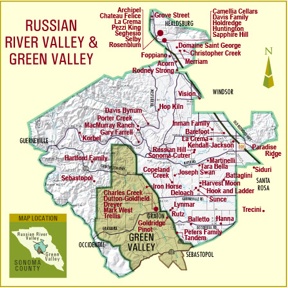The Foundation of Winegeekdom
 Here is why Steve Heimoff is a good reporter and a compelling commentator.
Here is why Steve Heimoff is a good reporter and a compelling commentator.
Today Steve wades into the issue of the theory of American Viticultural Areas and the process by which the TTB approaches the creation of these appellations. In this case, Steve ponders the implications of the TTB rejecting a petition to create a new sub-appellation of the Paso Robles AVA that would have designated the Westside of Highway as "Paso Robles Westside".
This is a critical subject because in theory an AVA or sub-AVA is supposed to identify and codify a well defined area that has distinctive growing conditions that set it apart from its neighbors. Such a well defined region should, in theory, deliver something distinctive to the character of the grapes grown within its boundaries. This idea that a region's specific climatic and geographic characteristics can deliver something specific to the grapes forms the basis for the notion that wines from a specific area should themselves have specific characteristics that the above average wine consumer can look forward to enjoying when they pop a cork on a wine made with grapes from said region.
This important notion forms the foundation for all Winegeekdom.
This writer believes that for Winegeekdom to have confidence in the American AVA system, that system must put much more emphasis on identifying much smaller, much more well-defined growing regions than it has in the past. American Viticultural Areas such as "Russian River Valley", "Sonoma Coast", "Paso Robles", "Napa Valley", and the like are way too big and way too encompassing of varied climates and geographic landscapes to have any meaning at all for the consumer. What we need are more appellations like "Green Valley", "Atlas Peak", "Howell Mountain" and "Sonoma Mountain": relatively small, well defined regions that DO deliver specific characteristics to the grapes grown there.
I'm hoping that Steve Heimoff continues to dig into this topic.

It’s high time they broke down the 500,000 acres of “Sonoma Coast”. It’s just silly.
If the AVA system were actually based on something like grape growing, Steve would be fighting an easy fight. The reason he’ll have his hands full is that TTB is a bureaucratic morass. Such entities don’t function as intended–they function as the wind blows, and I don’t mean climate.
Many folks are working on this issue. Check out Appellation America’s recent work. Spearheaded by Dan Berger, Clark Smith and Laura Ness, among others, they have made considerable inroads in breaking down AVAs into more discrete, terroir-sensitive locales.
Here, here! Just one more vote from a consumer in support for distinctive appellations. Thankfully some labels do much to report the originating bioregion. This helps until/if distinct AVAs will be formally designated.
I agree. Not only would this method help to better distinguish growing regions, but this more thorough categorization would add deeper meaning to the AVA itself. It could lead to AVAs meaning more than they currently do in the decision making process here in America.
“…is that TTB is a bureaucratic morass. ”
No I don’t think that’s it. TTB like all gov’t agencies exists according to processes. These processes evolve over time. I for one am glad to see a slow evolution away from kowtowing to the marketing concerns of producers.
Examples? How about “Sonoma Coast” – what a joke. Good marketing though. I was there during the establishment of “Stag’s Leap District” and wow you would not have believed the lobbying (ultimately successful) by the outliers for inclusion. And I think it is a shame that some deserving vineyards are left out of the Carneros appellation (also a successful marketing tool): depending on who I have heard the story from it was because an established winery didn’t want to lend their marketing cachet to upstarts, or it was because the proposals for inclusion were considered too broad, which led to equally broad criteria for exclusion.
Seems to me the criteria for an appellation should be simple: geographic contiguity, and relative homogeneity of soil and mesoclimate. And I know it is very un-American of me to think this, but I believe there should also be restriction of the varieties planted in an appellation.
Problem is, a simplistic and rigorous approach to defining appellations is a marketing nightmare. Robert Lautel received death threats when he used geology to move some lines in the appellation map of Burgundy.
“Seems to me the criteria for an appellation should be simple: geographic contiguity, and relative homogeneity of soil and mesoclimate. And I know it is very un-American of me to think this, but I believe there should also be restriction of the varieties planted in an appellation.”
Hear, hear.
Even Sonoma Mountain and Green Valley are complicated places. In Green Valley, for instance, if you’re in a lowland spot, it’s foggy and cool and you grow Pinot Noir. If you’re 800 feet up on a mountain (e.g. Morelli Lane) you’re above the fog and grow Zinfandel. Same AVA, completely different terroir. Doesn’t make any sense. That’s my problem with AVAs.
The name American Viticultural Area isn’t specific and I think they created it to be this way so that California and all other AVA’s in america had time to discover where specific varietals will grow thier best. When the growers commit to a more site specific way of thinking then the AVA system will evolve into an appellation type system. Growing grapes where they have no business being grown does nothing but mislead new wine drinkers into thinking chardoanny is supposed to be fat and oaky and cabernet is supposed to be jammy,oaky and have no ageability. You can keep classical varietal charateristics while expressing style.